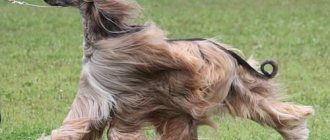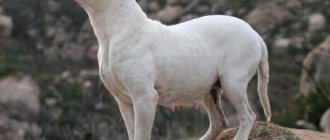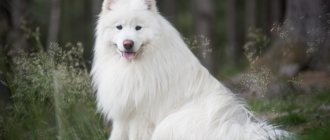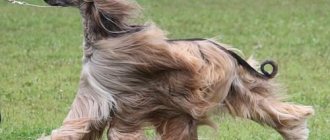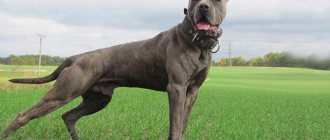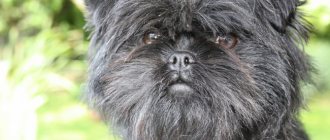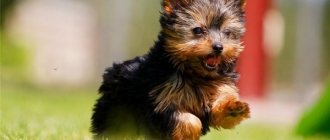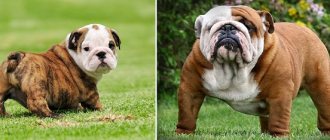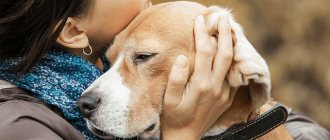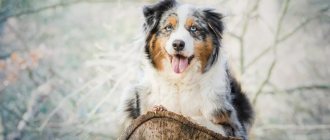Many people, when choosing a pet dog, are guided by the color of their coat. The black dog is a universal animal, since after it there are no traces of fur on upholstered furniture, and when walking it does not become easily soiled.
The appearance of black dogs at first glance shows dominance over other breeds, however, whether they are huge or black, their character varies depending on the breed and education. Let's take a closer look at the breeds of black dogs.
Newfoundland
Nobility and strength are the first two criteria that come to mind when you think of the Newfoundland Hound, better known as the Newfoundland.
Despite the large muscles, it maintains a harmonious silhouette, if not elegant, both in static conditions and in movement. His back is wide and straight. The legs are wide and round. Its head is massive with a large skull. The eyes are small, set in the sockets, widely spaced, dark brown in color.
Its fur is traditionally black. Its coat is long, flat (but short and fine on the head), dense, waterproof, as is the thick and soft undercoat. Its limbs are fringed and its tail is covered with long, thick hair.
The average male reaches 71 cm at the withers and weighs from 60 to 70 kg. Female dogs average 66 cm at the withers and weigh from 50 to 60 kg.
But what makes the Newfoundland especially interesting is its strong personality, thanks to its subtle mixture of dignity, loyalty and patience. His impressive strength combined with his lively intelligence makes him a versatile dog: if he excels in beauty shows and in various working disciplines (water, pulling, obedience, etc.), he is above all an ideal family dog. And a wonderful companion for all times.
Newfoundlands also come in chocolate and Landseer (black and white) colors, but black is by far the most common color in this friendly family dog.
They require frequent brushing, especially as the seasons change, to prevent a buildup of undercoat that can become matted and uncomfortable.
Newfoundlands were bred to catch nets out of the water, and they love to swim, especially because their thick black coat can cause them to overheat in the summer.
This breed of dog needs daily walks, especially because they are prone to obesity, which can cause major health problems. A dog constantly needs communication.
Genetics of color
As everyone knows from school, the carriers of heredity are chromosomes, each of which has a certain set of genes. They are designated by letters, the characteristic genetic features are indicated in the formula, where the name of the genes is indicated in detail. The number of chromosomes is constant for each species, and each chromosome has a pair. In total, a dog has 39 paired chromosomes. There are two types of genes:
For example, to show the dominance of a black color gene over brown, B > b is indicated. Gene A determines the uniform distribution of color pigment throughout the hair. Gene B is responsible for the formation of black color.
The genetic formula of an all-black puppy appears to be AB. Genes C and D determine the intensity of color. According to this formula, a black dog is ABCD. Gene E is responsible for the distribution of black color throughout the body. The solid black color looks like EEBB. To obtain a black color, the presence of B and E is necessary. The G gene determines age-related changes in coat color, g - indicates the absence of such changes.
The M gene is responsible for spotting, m - indicates uniform pigmentation. The S series genes determine hair depigmentation and white spotting. T – indicates a dotted color, t – the absence of specks. The R gene determines such a feature as roaning, and r - normal color. The W gene determines the dominance of white color, w - indicates the usual color.
An example of the genetic formula of a black dog looks like this: ABCDEgmStrw, where:
Rottweiler
The Rottweiler is one of the oldest dog breeds. He came from a line of Tibetan mastiffs. They guarded the camps of Ancient Rome.
The Rottweiler is a dog with a massive and energetic body that combines strength, flexibility and endurance. It is medium in size (61 to 68 cm in males) and weighs about 50 kg.
Her brown almond-shaped eyes express tenderness and devotion. He is really very attached to his owner, whom he watches closely.
This dog has good nervous balance. Quite placid in his mood, he will be a pleasant companion for the whole family if he is well educated.
A well socialized and trainable Rottweiler is a great creature that will work daily and look after its home. A poorly socialized Rottweiler without exercise and training can become a danger to others.
The Rottweiler may not be the ideal dog for first-time owners. From infancy, he needs to be trained, develop communication and train. Originally bred in Germany to pull carts and herd cattle, the Rottweiler is now celebrated at its best.
Despite their scary reputation, Rottweilers that receive enough exercise, socialization, and training can make excellent pets. Rottweilers love to eat, which is why they are prone to obesity.
Doberman
A popular smooth-haired breed about which there is a lot of controversy. Some argue that there is no friendlier dog in the world, others believe that it is very aggressive, and keeping it in the house is madness. At first it was so, because the purpose of breeding the Doberman was protection, and aggression was very characteristic of the first representatives of the breed. Now, after the breed has been improved by breeders, the dog has no uncontrolled aggression, while its protective functions are preserved. Dobermans get along well with children and respect their owners. They get along quite well with other pets. The weak are not bullied.
As long as there is no danger, there is no more good-natured dog than the Doberman. As soon as the dog believes that something is threatening its owner, it transforms into a decisive and fearless defender. If you raise a Doberman correctly, he understands his owner without words. Caring for a Doberman is simple - wipe the dog with wet wipes and comb it once every seven days. Swimming 4-5 times a year is enough.
Neapolitan Mastiff
Comes from the oldest families of dogs and was a companion of Alexander the Great, as well as Cyrus and the Phoenician sailors. For a long time he enlivened the arenas of the Colosseum in Rome. Despite the fall of the Roman Empire, he remained guardian of the villas in southern Italy. Saved from extinction at least, it was only in 1946 that he began to be seen at exhibitions.
The Neapolitan Mastiff, a breed of Italian origin, is a powerful mastiff of impressive build with a massive, broad head and short muzzle - this is the image of a mastiff.
This wrinkled face with a well-defined square shape remains very characteristic of the Neapolitan Mastiff breed. Its well-built body is covered with short hair, the color of which ranges from fawn to black through various shades of gray.
Sturdy, rustic, imposing, this is an excellent guard dog, but also a good family companion, although it enjoys dominating its companions.
He needs exercise and is not content with a living space that is too small. Early education can only help the good integration of this companion, whose guarding instinct is innate and sufficient. The Neapolitan Mastiff needs to be exercised and cannot be kept indoors for too long.
Bearded Collie
Remember Cousin It from the movie The Addams Family? So a bearded collie would be an ideal pet for him. Dense, slightly wavy and incredibly soft fur covers the entire body of the dog, covering his eyes with his bangs. The breed was bred in Great Britain as a herding dog, which in the modern world is valued as nanny dogs. Friendly in nature, the dog has an inquisitive mind and is easy to train.
It is believed that the bearded collie, like all collies, is well suited as first dogs, because all the difficulty lies precisely in the content of the coat, and training and education come as a package with the dog, requiring standard training from the owner. More experienced owners note that the breed is excellent at mastering sports disciplines and, with proper upbringing, is ready to perform at the international level.
Giant Schnauzer
Originally from Bavaria in Germany, the Giant Schnauzer accompanied coachmen from one relay race to the next, living with the horses in the stables, hunting rats, field mice or any other rodents. Its name comes from the word "schnauz" (muzzle) due to its characteristic muzzle, adorned with a beard and mustache.
Requires a lot of firmness and attention, does not tolerate cruelty and unfair reprimands. He is by definition not a submissive dog and therefore requires the complicity and great understanding of his owner.
Schnauzers belong to the same family. Affectionate, loyal, brave, vigilant, but not restless dogs. Their fur is black. Black and silver colors are very popular, white is exceptional for the toy breed. The giant's dimensions range from 60 to 70 cm and weigh from 35 to 45 kg.
The Giant Schnauzer is comfortable everywhere. A good companion dog, will easily live in an apartment if given the exercise and space necessary for its vitality (2 long walks per day required).
Affenpinscher
The Affenpinscher is one of the smallest dog breeds, originally from Germany. In addition to black coat color, the Affen is found in tan, silver, gray and red colors. This is an active, strong dog that is agile enough to catch rats and mice. The Affen has a monkey-like facial expression with long eyebrows and a beard, which gives it a comical appearance.
The Affenpinscher lives up to its name - "monkey pinscher" - both in appearance and in behavior. The Pinscher is always busy, inquisitive, cheeky and stubborn, but he is also playful and mischievous. He gets along quite well with other dogs and pets. This small dog is best suited for a family that loves fun and has a very good sense of humor.
Black Russian Terrier
A dog created by the Russians in the early 20th century from an Airedale terrier crossed with a Giant Schnauzer and a Rottweiler, it was used to guard military buildings.
These are strong dogs of above average height with massive bones and muscles. They are strong and rustic. The skin is dense, elastic, and does not form folds. Dogs of this breed are biting, suspicious of strangers, and persistent. They adapt well to different climatic conditions and are receptive to learning.
This type of dog is extremely nervous, energetic, balanced, restless, with strong defensive reactions.
The coat is coarse, hard, close-fitting, 4 to 10 cm long, covering the entire body. On the muzzle it forms a coarse stubble of whiskers on the upper lip and on the lower part, like a beard. The eyebrows above the eyes are rough and thick. The longer hair on the neck and at the withers forms a mane. The forelimbs up to the elbows and the hind limbs up to the hips are protected by coarse and long hair. The undercoat is dense and well developed. The color is black or black with gray hairs.
He has a very strong and balanced character. He is very loyal to his owner. Distrustful of strangers, very lively in his defensive reactions, he is an excellent watchdog. He can adapt to city life if he is used to it from an early age and if he enjoys long daily walks.
Havanese Bichon (Havanese)
If you are not a fan of brushing your dog every day, then this breed is definitely not for you. The soft, wavy coat always maintains a decent amount of volume, and if the Bichon moves, it is not entirely clear where the head is and where the tail is. The breed began to take shape thanks to the Spanish colonization of Malta. Later, the Cuban aristocracy fell in love with the adorable little dogs.
Despite its small height and weight, this small shaggy dog has strong muscles and is easy to train, is able to learn tricks and is generally famous for its docile character. Coat care is problematic, as with all shaggy dog breeds, since in addition to daily combing, it is necessary to regularly monitor the formation of tangles.
Cane Corso (Italian court dog)
The Cane Corso is a direct descendant of the mastiffs used by the Roman legions. Its name comes from the Latin cohors, which means "protector, keeper of farms." The dog was used as a fighter in the arenas of Ancient Rome, a bear hunter, and later as a cattle keeper.
The dog is quite large in size, strong and strong, but at the same time elegant. His favorite gait is the trot, which reveals his powerful muscles. The body is slightly longer than tall, strongly built, but not stocky. The tail is natural, set quite high, very large at the base. The ears are triangular, drooping, and medium in size.
The nose is black, voluminous, with large, well-open nostrils. The muzzle is strong, square, flat, shorter than the skull. The eyes are medium-sized, dark, depending on the color of the coat. The look is lively and attentive.
The coat is short, shiny, very dense, with a thin undercoat. The coat color is black, sometimes gray, brindle (stripes on a fawn or gray background of various shades). A small white spot on the chest, limbs and muzzle is allowed. The male measures from 64 to 68 cm and weighs from 45 to 50 kg, and the female measures from 60 to 64 cm and weighs from 40 to 45 kg.
Her calmness and poise are legendary. She is very attached to her owners and will not hesitate to intervene in case of danger. She usually does not pose problems in the family. The dog should receive a strict, but not harsh education. A sporting dog is highly disciplined—this includes agility, obedience, sport, or tracking utility.
Pekingese
This shaggy miracle was bred in Tibetan monasteries, where it initially served as a companion dog and bell dog. The fact is that Pekingese were kept in pairs with mastiffs. The first gave a loud signal by barking about the approach of a stranger, and the second was sent to directly guard the entrusted temple. It is distinguished by thick fur and a flattened muzzle.
They love to walk and play, but get tired quickly, so they are good for active pensioners, but not for children with children. They easily master basic commands, but due to the peculiarities of their skeletal structure they are not suitable for sports disciplines. Many owners note the therapeutic and calming properties of the breed, saying that Tibetan monks put all their age-old wisdom into them. But more down-to-earth owners note that the breed also snores.
Black German Shepherd
The creation of the German Shepherd is credited to Captain Max Frederick Emil von Stephanitz, who used various herding dogs from central and southern Germany to create what would become the most popular dog in the world.
The German Shepherd is of medium height, slightly longer than his height, strong, muscular, and well built. The line of the back is slightly hanging. The German Shepherd is a “trotter” with wide movements and a harmonious appearance. His wedge-shaped head is a beautiful black mask, and his piercing and lively gaze is recognizable among all other breeds. His almond-shaped eyes are dark and his nose is black. The size of males is from 60 to 65 cm at the withers, in females from 55 to 60 cm with a weight of 22 to 32 kg.
The German Shepherd's coat is black and comes with reddish-brown, brown or yellow markings. The coat is double: the top layer is very thick, straight, coarse and well laid out, covering the undercoat, which is also thick.
The breed standard specifies that the German Shepherd must be well balanced, confident, completely natural, completely harmless (except when excited), alert and obedient. The Sheepdog exhibits courage, has a strong character and a fighting instinct to meet conditions that make it suitable for being a companion dog, guard dog, protector, servant and working in herds.
He is an active and athletic dog, more suited to country life, but adapts well to city life provided he benefits from frequent walks. The German Shepherd does not support solitude, and there is no question of leaving him cooped up for several days in a row.
It is important to be able to engage in different activities with her: dog sports, as well as running, ball games or just walks.
Varieties of colors
Color or suit is the main color of a dog's coat. It is inherited from parents, and it is essentially impossible to influence it. The colors of the varieties are officially designated in the breed standard and are its characteristic features. There are basic colors on the basis of which all others are formed: white, black, brown and red. Coat color is produced by the pigments eumelanin (brown, black) and pheomelanin (red), and their absence determines the white color.
In addition to the actual color, it is customary to distinguish also the color, which implies the presence of spots (white and yellow spotting), as well as the presence of tans, marks or specks on the coat. The color can be one-, two- and even three-color. In animals of the same color, individual parts of the body may stand out in a different color, or there may be a characteristic spot in a specific place, most often on the chest, neck or muzzle.
The color of the dog is always included in pedigrees, but if the coat has several colors, which are located in specific places and have a set shape, then the name of the color is indicated by color. Complex colors are usually called in comparison with the natural coat color of wild animals: brindle, wolf, sable, deer.
All colors are divided into several types.
Solid
Solid or single-color suits, they are, in fact, colors, contain only one pigment or, in principle, do not contain it. Moreover, it is dispersed in the hair non-zonally, that is, everywhere equally. Accordingly, there are 3 types of solid colors: light, dark, white. With an intense content of the eumelanin pigment, a brown or black color appears, and with its desaturation, a beige or blue color appears. But the presence of the pheomelanin pigment at a stronger concentration provides a red color, and at a weaker concentration it provides a sandy color.
Both of these colors have a large number of shades.
Mixed
Such colors contain 2 pigments - light or dark, and the white color is completely absent. Taking into account the ratio of these two pigments, mixed colors are divided into:
Moreover, there are options with replacing the red color with sand, and black with brown.
Modified
These colors appear based on solid or mixed colors that have changed as a result of phenotypic expression. They are divided into 3 types:
Labrador
A cute, calm, strong Labrador inspires the confidence of every person. His eyes are medium in size and brown or hazel in color.
This is a strong built dog. Its tail, very thick at birth, gradually tapers towards the end. It is completely covered with short, thick, dense hair, which has a rounded shape.
The coat is free of ripples and fringes, and the undercoat is weather resistant. The color is completely black, sometimes yellow or brown (liver-chocolate). The yellow color ranges from light cream to red (fox). In males, the withers reach 59 cm, in females from 51 to 58 cm.
The Labrador is an active dog that needs exercise. A calm dog, he knows how to live both in the city and in the countryside.
A lively and strong Labrador must “serve” and feel in harmony with its owner. Attentive, loyal, playful and intelligent, his unfailing love for his owner makes him do everything for him. He is very patient, calm and naturally friendly.
Very agile, endowed with a wonderful nose and an amazing visual memory, he has a “sweet tooth” and is animated by a passion for water, which makes him a dog especially adapted to hunting in swamps, where he can withstand extreme conditions. A faithful comrade who knows how to adapt everywhere. He knows how to be pleasant, playful or sporty at the same time.
These qualities make him an excellent working assistance dog for people with visual and physical disabilities, a rescue dog and a research dog.
Norwegian Black Elkhound
The Black Norwegian Elkhound is a typical Spitz dog breed, originally from Norway. It has a short compact body, dark eyes, erect ears and a curled tail. The breed is distinguished by its rich coat, glossy black in color. This is an all-weather hunting dog, and its coat can withstand the heavy autumn rain in Scandinavia and withstand cold weather, which is very important.
The Black Norwegian Elkhound is a very strong and resilient dog. He needs continuous physical exercise and mental stress. This is a wonderful hunting dog that loves to be in the forest. The Black Norwegian Elkhound does well with children and loves to play with them all day. However, he should not be raised harshly, as this may lead to overly aggressive behavior. Because this breed has a strong will, owners must understand the dog and learn to subdue it without being harsh. This is an excellent hunter, and will also entertain all family members with its activity and funny behavior.
Swedish Lapphund
The Lapphund bears some resemblance to a wolf, with small triangular ears slightly rounded at the tips, and a tail curled over the back. This is a strong dog with a solid build, capable of thriving in any type of terrain, especially in the mountains and in the water. The dog's coat is resistant to weather conditions.
The dog is medium in size (48 cm for the male and 43 cm for the female). The body fits into a rectangle whose length is slightly greater than its height. The eyes are expressive, round and dark brown. His gait is wide and light. The fur consists of abundant straight and coarse hair, longer at the level of the chest, tail and back of the limbs. The undercoat is very soft, dense and finely curly.
Smart, agile, brave and cheerful, the Lapphund loves to work and please his owner. He is a versatile and expressive dog. Lapphund requires a solid and consistent education (especially the first year of training). He learns very easily and can excel in many disciplines such as agility, obedience, tracking or even waterwork.
The Swedish dog is a rare breed due to its numbers, but it deserves interest, in particular due to its training abilities, its watchdog qualities, but above all because it is a charming companion for the whole family!
What breeds are there?
There are quite a few breeds that stand out for their beautiful black color.
Large
Among large breeds, there are quite a few representatives with black coats.
Black Terrier
Belongs to the service variety and needs an experienced owner. Representatives of the breed have excellent guard qualities, but at the same time they are faithful companions. Their character is reserved and flexible, so they are frequent participants in exhibitions and competitions. Despite its large size, the animal is affectionate and friendly. The black terrier does not show aggression, has a good disposition and extraordinary intelligence.
In addition, the animal is very loyal and obedient . Representatives of the breed are easy to train and have high performance. The coat is thick with a rigid structure; a beard of longer hair is formed on the muzzle, as well as flowing bangs. Dogs have excellent health and rarely get sick.
Giant Schnauzer
This is also a guard breed. The dog has a strong psyche and incredible devotion . Their extraordinary appearance and excellent characteristics contribute to their participation in various exhibitions. Thanks to their good mental abilities, animals learn very quickly. They are great with children; Giant Schnauzers make excellent nannies.
Despite its friendly disposition, the dog is able to protect its owner without hesitation. She is very hardworking and active, so she needs frequent walks and exercise. The coat of the breed is thick and quite hard, there is a dense undercoat and outer hair. The dog has a peculiar beard and bushy eyebrows.
Irish Wolfhound
Large and majestic, the Irish Wolfhound is the tallest dog breed recognized by the AKC. It was originally bred as a big game hunter. While their ancestors date back to ancient times, the Irish Wolfhound first gained popularity in the 15th century to help control the wolf population in Ireland. Today, Irish Wolfhounds are known as worthy, attention-grabbing companions.
How to choose
There are certain rules that you should consider when going to buy a puppy. When choosing a long-haired pet, several other aspects are taken into account.
First of all, you need to ask the seller about the parents of the baby you like, since it will depend on them what kind of character the dog will have.
There are large nurseries in Moscow, Samara, Nizhny Tagil. There are branches in all major cities that will be happy to help you find a suitable puppy. In addition, in most cases, pets are already vaccinated.
It is best to buy fluffy puppies from specialized nurseries, and not from hand; unverified sellers often sell defects.
Tibetan mastiff
A huge shaggy dog that you will never forget once you see. The breed amazes not only with its incredible thick coat, but also with its size. The height of a show dog ranges from 66 centimeters, but mastiffs in their homeland, which are still raised as watchdogs, are much larger.
The breed is not very common, and like all giant dogs, it is difficult to train and maintain. Accustoming a dog to grooming is a lot of work, teaching it to get along with people is even more difficult. It is recommended to own a Mastiff only for very experienced dog breeders or people who are constantly in contact with the breed at their place of residence.
Schipperke
Another black shepherd, only from Belgium. True, it can be called a shepherd dog only by its habits and official duties. In fact, she looks more like a Spitz, both in appearance and in size. The average weight of such a black “devil” is 4-6 kg.
Read List of the best cartoons about dogs - TOP 50
Breed standards allow only black color of the animal's two-layer coat. Due to the fact that the hair on the Schipperke's neck is slightly longer, a mane is formed that looks like a lion's. The smoky black coat of this dog breed needs to be brushed several times a week, and every day during shedding. It is very suitable for those owners who would like to have a shepherd, but the square meters do not allow this.
General recommendations for caring for a furry cat
When breeding shaggy dogs, it is important to adhere to two rules: regularly care for the coat and provide adequate nutrition. If a pet is deficient in any element, this will certainly affect its main advantage - its coat.
The diet should contain foods rich in the following substances:
If you decide to use store-bought feed, then take premium complexes. For care you will need special brushes and shampoos.
Regardless of what kind of pet appears in the house, you need to remember that it requires not only care, but also attention. There are breeds that have a hard time withstanding loneliness and prolonged separation from family members. These and other facts are important to consider when choosing a pet.
Source
Collie
You won't find a smarter dog among herding dogs. Imbued with aristocracy, the collie knows its worth from birth. Of course, this long-haired beauty loves to play, is not against learning sports disciplines and will zealously follow all your commands, but in moments of rest the collie is not just a dog - it is a great helper and joy for the owner.
Thick wool with a dense soft undercoat has many colors, but such a coat needs to be combed once a day, and during the molting period it would be a good idea to use a slicker brush.
Modern collies are famous as independent nannies. Well-trained dogs are able to independently look after a 6-year-old child on the street, and a smaller child at home. The dog does not allow you to leave the permitted territory, and if a stranger approaches, it will first give a loud signal by barking, and then completely rush at the stranger. The breed is now far from at the peak of popularity due to its size, but anyone who has owned a collie at least once will never want to have any other breed at home.
Source

